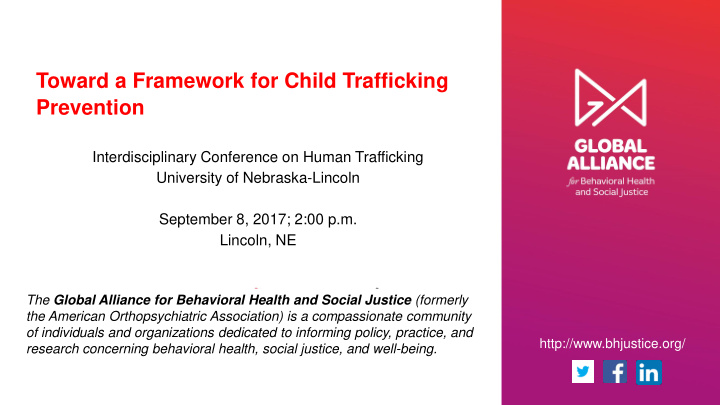



Toward a Framework for Child Trafficking Prevention Interdisciplinary Conference on Human Trafficking University of Nebraska-Lincoln September 8, 2017; 2:00 p.m. Lincoln, NE The Global Alliance for Behavioral Health and Social Justice (formerly the American Orthopsychiatric Association) is a compassionate community of individuals and organizations dedicated to informing policy, practice, and http://www.bhjustice.org/ research concerning behavioral health, social justice, and well-being.
Why focus on primary prevention? “ Intervening during the trafficking process may be a case of ‘too little, too late’ unless the factors that determine the behavior of crucial actions are also addressed…” – Dottridge (2006) “ Why have we seen so little progress in reducing the prevalence of child trafficking and related forms of exploitation? … the reality is that most of the work continues to focus on prosecuting perpetrators and, to a lesser extent, on assisting survivors. Few significant efforts have been aimed at prevention.” – Todres (2014)
Framework Development Process Search Criteria • 2009 1 -present • Keywords: “child*,” “trafficking,” and “prevention” (not included if merely mentioned legislation that included these terms) Reports from U.S. Nongovernmental Academic and International Organization Literature Governing Bodies Reports 23 articles 124 reports 12 reports 1 Nine document were published before 2009 but were included in the review because they were cited in many of the documents reviewed and/or because of the prevention focus.
How is prevention defined? Are particular populations identified as Questions being at risk, and if so, what factors contribute to the increased risk? guiding the What, if any, strategies are mentioned for review preventing child trafficking? Are children at risk of becoming traffickers discussed, or is the focus exclusively on children at risk of becoming trafficked? Is a theoretical framework for prevention provided, and if so, how is it described?
Key Findings: What we know about child trafficking prevention Lack of consensus about the meaning of “prevention” as it relates to child trafficking Little, if any, discussion of primary prevention, which then limits the capacity to prevent trafficking Prevention strategies often do not address the factors that lead to vulnerability to becoming trafficked or becoming traffickers Demand often is not addressed
Well-being (inclusive of a socioecological Findings: approach) Frameworks Public Health Human Rights
Rationale for a More Robust Approach HR approach tends to view children as passive, not active, actors. Some of the articles in the CRC are paternalistic. The legalistic approach of human rights does not encourage development of peoples’ awareness of themselves as active social agents. HR is historically focused on government actors. Public health approach may become enmeshed in trying to document the extent of the problem. Although public health approaches emphasize primary prevention, strategies are sometimes narrowly focused on education or awareness raising.
Advantages of the Capability Approach Ability to contextualize/tailor to the local community Recognition of diversity in resources and ability to translate resources into opportunities Focus on agency & participation Refers to interaction and relationships, not just individual or social resources Emphasis on identifying sources of ‘unfreedom’ (e.g., discrimination) as a necessary, but not sufficient. Must also foster opportunities for people to engage with what they regard as valuable ways of being and doing Acknowledges the fallacy of one-size-fits-all approaches Compliments the human rights and public health approaches
Capabilities Approach
Guiding Principals for Conversion Factors Strategies are oriented towards respecting and supporting the relationships that are most important to children Children and youth have opportunities to actively participate, including participating in decision making of community structures Opportunities are guided by principles of universality and inclusiveness Strategies are child-centered, but family-focused Community investment in children and youth promotes family functioning Comprehensive Tailored to community strengths and resources
Examples of Conversion Factors Individual Community Opportunities to participate Engaged community members Social norms Supported in decision making Inclusiveness Access to basic necessities Supportive of parents/caregivers Relationships Societal Structures to enable supportive and caring Policies that promote non-discrimination connections between adults (e.g., gender equity, migration, etc.) and children Institutions oriented towards promoting Structures to promote family functioning positive peer connections Policies or incentives that promote corporate responsibility
Burchardt and Vizard (2008) Biggeri (2003) The capability to be alive; Be healthy Life and physical health Enjoy individual, family and social life Love and care Engage in productive and valued activities; Participation/information Participate in decision-making, have a voice Capability and influence Be knowledgeable, to understand and Education Set reason, and to have the skills to participate in society Freedom from economic and non- Enjoy a comfortable standard of living, with independence and security economic exploitation Social relations Enjoy individual, family and social life Leisure activities Respect; Shelter and environment The capability of knowing you will be protected and treated fairly by the law Religion and identity Being and expressing yourself, and having self-respect Mobility Bodily integrity and safety Live in physical security Time autonomy and undertake projects Mental well-being
Capability Set Conversion Factors Resources
Application of the Framework For evaluation, ask children, “What are the most important opportunities a child should have during his/her life?” Evaluate the program/policy based on children’s perceptions of how much it improved their opportunities within each of the identified areas. For grant makers and administrators, ask potential funding recipients to describe how their programs/strategies will improve opportunities for children within the identified capability set. (have funders work with children to first ID capabilities?) Do outputs translate into outcomes? Have policies promoted access to specific functionings (outcomes)? For policy makers, importance of disaggregated data; importance of requiring input from children; evaluate policy proposals based on whether they improve opportunities children have reason to value. Do policies take diversity of needs into account? To what kinds of (alternative) functionings do policies promote access? How much choice do individuals have between alternative functionings? (Goerne, 2010)
Contact Us Robin Kimbrough-Melton robin.kimbrough-melton@ucdenver.edu Jill McLeigh jill.mcleigh@ucdenver.edu Mary Sullivan mesullivan@neb.rr.com
Recommend
More recommend